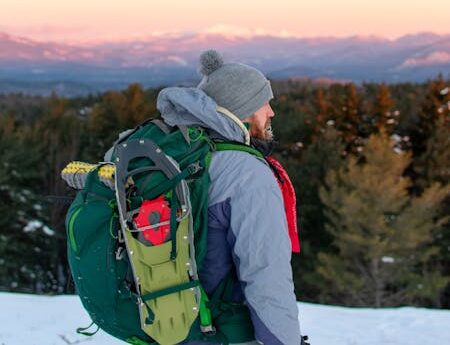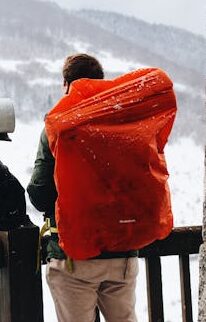
Packing a backpack might seem straightforward, but doing it the right way can make or break your hiking experience. Mindful packing not only ensures comfort, but it also helps you stay organized and makes your gear easily accessible on the trail. While there’s no single “correct” way to pack, following a few key principles can help you hike smarter and enjoy your trip more.
How Should You Pack Your Backpack For Hiking?
This guide covers all aspects of your backpack from choosing the right pack to how to pack it, even how to hoist it. Let’s dive into how to pack your backpack like a pro!
The Importance of Mindful Packing
Packing your backpack thoughtfully isn’t just about cramming everything in and hoping for the best. It’s about making sure your gear is easy to reach, your pack feels balanced, and your load is as light and stable as possible. When done right, a well-packed backpack will be comfortable to carry, and the items you need on the trail will be close at hand, ensuring you don’t have to dig through your bag to find something buried at the bottom.
Choosing the Right Backpack
Before packing, make sure your backpack is suitable for the trip you’re taking. I once made the mistake of using my husbands framed basckpack. Half way into my hike, the frame was rubbing on one hip which became painful and uncomfortable. Don’t make the same mistake I did – here’s what to consider:
- Volume: For day hikes, a pack around 20-30 liters should be enough. For longer, overnight hikes, you’ll want something in the 40-70 liter range, depending on how much gear you carry.
- Fit: A well-fitted backpack is crucial for comfort. Adjust the hip belt first—this should take on the majority of the weight. Then, tweak the shoulder straps and sternum strap to snugly secure the pack to your body. Make sure the load sits close to your back. You can check out my comprehensive guide on fitting a backpack for more detail here.
Packing Zones: Where Everything Goes
Now let’s get into the actual packing process. Think of your backpack in zones—this helps keep your gear balanced and easy to access.
Bottom Zone: This is where you want to stash bulky, soft items that you won’t need until you’re at camp or during rest stops. Sleeping bags, sleeping pads, or camp shoes are good candidates. These items also provide a nice cushion for your back as you hike.
- Core Zone: This is the heart of your pack, where you’ll store the heaviest gear. Place things like your food, cook kits, water reservoirs, or even a bear canister here. Keep these items as close to your back as possible—this will help maintain your center of gravity and keep you steady on the trail.
- Top Zone: Store lighter items that you might need during the hike, like an insulated jacket, first-aid kit, or water filter. These should be easy to grab without unpacking everything else.
- Accessory Pockets: Use the side or front pockets for things you’ll want quick access to, like snacks, a map, sunscreen, lip balm, or your headlamp. Having these essentials within arm’s reach will save you time. A big tip is to put you car or house keys in one of the small accessory pockets and do not put anything else in the pocket and keep it closed the whole hike. Yes, I once lost my car key on a hike as I had it in an accessory pocket with other items in it and I didn’t notice it fall out. Causing me a world of pain when I went to get in my car!
- Tool Loops and Lash Points: These are perfect for attaching oversized gear that won’t fit inside the pack, like trekking poles or tent poles. Just avoid hanging too many things outside your bag, as they can get snagged on branches or rocks and throw off your balance.
Weight Distribution is the Key to Comfort
A balanced load is essential for a comfortable hike. Always pack the heaviest items near the middle of your back, closer to your spine. This keeps your center of gravity stable, making it easier to navigate tricky terrain. Lighter items can go on top, and keep frequently used items in outer pockets or compartments for easy access.

Packing Tips to Maximize Space
- Visualize Your Pack: Think of it like playing Tetris. Fill every nook and cranny with gear, so your pack stays compact and doesn’t shift as you walk.
- Balance Your Weight: Make sure the load is evenly distributed on both sides of your backpack to avoid unnecessary strain on your shoulders.
- Compression Straps: Once packed, tighten the compression straps on your backpack to keep everything snug and in place.
- Use Stuff Sacks and Compression Bags: These are great for organizing your gear and squeezing extra space out of your backpack. Waterproof stuff sacks are ideal for keeping electronics or clothing dry, while odor-proof bags are a must for food storage.
Keeping Your Gear Dry
Nothing spoils a trip like soaking wet gear. Always pack waterproof gear, like a pack liner or rain cover, to keep your items dry. Keep your rain jacket or poncho outside the pack liner for quick access in a sudden downpour.

How to Hoist a Fully Loaded Pack
When it’s time to pick up your loaded backpack, don’t yank it by the shoulder straps—that can damage the pack. Instead, grab the haul loop (the sturdy strap at the top of your pack), rest the pack on your thigh, and then slide it onto your back. It’s a good idea to practice this at home so you can easily lift and adjust your pack during your hike.
More Packing Tips
- Test It Out: Before heading out, try walking around with your fully loaded pack. This will help you figure out if it’s packed well and balanced.
- Organize by Color: Using color-coded stuff sacks or ziplock bags can make finding your gear quick and easy. Plus, it keeps everything organized.
- Consistency is Key: Pack the same way each time so you always know where your essentials are when you need them.
By following these packing strategies, you’ll ensure a more comfortable and efficient hiking experience. Whether you’re heading out for a short day hike or a multi-day adventure, mindful packing is the first step to a great trip.
Packing smart is all about preparation, balance, and accessibility. With these tips, you’ll hit the trail ready for anything and not make the mistakes I have! Happy Hiking.
If you have any packing questions or experiences you would like to share, please leave your comments below.
